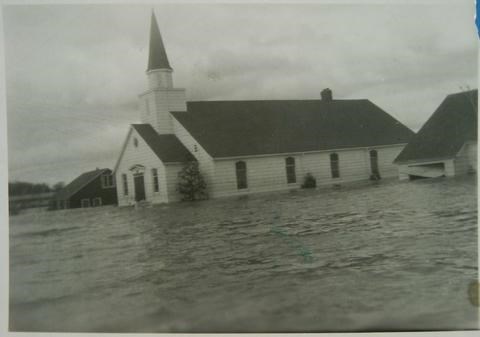In July of 1956, torrential rain, hail and a cyclone hit Holland Marsh Gardens in the Springdale area. The twister cut a track half a mile wide, damaging crops. But according to the Bradford Witness, the damage was grossly exaggerated by outside news agencies. While crops “took a terrific beating,” the article stated, “the statement in daily papers and over the radio that the storm had left gardeners ruined financially and that a relief fund had been set up in Bradford for them was untrue and is embarrassing.”
Another tornado hit Bradford West Gwillimbury on Aug. 5, 1981 at 3:30 p.m. Most impacted were homes on Fletcher Street, where shingles were torn off roofs, trees uprooted, and the pillars on a front porch blown down. Although described as a tornado, the storm, which lasted just two to three minutes, according to reports, sounded more like a classic microburst, which is a downdraft with horizontal winds reaching more than 100 km/h.
There was no doubt about the storm that hit southern Ontario in 1985, though. On May 31, a major storm system generated an outbreak of tornadoes in both the U.S. and Canada. The Barrie tornado was classified as an EF3 to EF4 storm that damaged up to 300 homes, injured 155 people and killed eight. A second tornado, generated in the Grand Valley area, cut across Ontario to the south of the Barrie track — narrowly missing Bradford and Newmarket, but causing damage in the rural areas, and knocking down barns and sheds on County Road 88 and in the Holland Marsh. For years afterwards, debris flung into the trees in the Holland Marsh area by the twister could still be seen there, including a mattress.
Ice storms, hail, torrential rains — Bradford West Gwillimbury has seen it all, but nothing matches the devastation produced by Hurricane Hazel back in 1954. The storm had its start near Cape Verde on Oct. 4, off the west coast of Africa. Within 36 hours, it had strengthened into a hurricane and was given a name. Hurricane Hazel tore into Haiti with 185 km/h winds and made landfall on the continental U.S. near Cape Hatteras, pushing a 4 ½-metre storm surge. Expected to swing back out over the north Atlantic, instead Hazel roared inland, heading toward a southern Ontario already saturated by days of rain. There were weather warnings, but no one predicted the intensity of Hazel when she hit, creating flooding, blowing down trees and hydro lines, sweeping away bridges. In the Holland Marsh, it was a disaster. Pumps were unable to keep up with the flow, and the dykes were breached, flooding the entire marsh — to a depth of up to 3.6 metres west of Highway 400.
Most residents of the marsh fled as the waters rose. The dePeuter Family — John, Catherine and their 12 children — were still at home when the floodwaters starting coming under the door around 8:30 p.m. They sealed up the doorway, which was a mistake: the wood frame house, sealed, floated off its foundation like a ship, carrying the family with it. Upstairs, the family rushed from side to side to keep the house upright, as it floated, bumping into homes, sheds and power lines. The rocking motion made at least one family member seasick. The house finally washed ashore beside Highway 400, and the de Peutres were rescued.
Edo Knibbe remembers that after the storm, he could look out over “a Holland Marsh that was now a large lake. Only the roofs of the houses seemed to be above water.” Despite the flooding, there was only one death reported in the marsh — John Naggi, 40, described as a recluse. His body was discovered in the frozen canal just before Christmas. It was a different story to the west, near Beeton, where five people were swept off a bridge spanning a branch of the Boyne River. Four of the victims — Otto Haugh, his wife and uncle, and friend Robert Edgar — were trapped on the roof of their car as the water rose around them. Rescuers successfully sent out a small rowboat on a tow line, and the four were able to climb aboard, but the boat capsized as they were being pulled to safety, and they all drowned. The fifth victim, Ervin Joyce, 22, had been swept from the same bridge minutes earlier.
Marsh residents found shelter at an emergency camp set up on the grounds of the Bradford Community Centre, while hot meals were served up at the Old Town Hall, now the Treasury Building. The relief effort was huge — the Bradford Lions Club collected food; the Red Cross distributed clothing from the ice rink on John Street, the Orange Hall and the United Church; the Rotary Club established a relief fund; and women’s organizations prepared 2,000 to 3,000 meals every day. Even as the community came together to help, huge pumps were brought in from Steep Rock Mines in Atikokan, west of Thunder Bay, and Ontario Hydro, to drain the flooded Holland Marsh.
— From Bradford West Gwillimbury Public Library Archives, Bradford Witness and other online sources.



